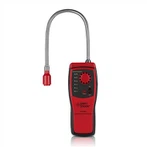A brief analysis of the distance coefficient of an infrared thermometer is as follows
The distance coefficient of the infrared thermometer is determined by D:S, where D represents the distance between the thermometer probe and the target, and S represents the diameter of the light spot.
To facilitate understanding, use a flashlight as an analogy. The beam of a flashlight is divergent, and the farther away it is, the larger the light spot transmitted on an object. D is the distance from the flashlight to the object, S is the diameter of the light spot, and their ratio is called the distance coefficient ratio. The difference is that the infrared thermometer purely absorbs the infrared waves radiated by the object, while the flashlight emits visible light.
When using an infrared thermometer, the target to be measured should fill the field of view, usually 1.5 times.
For a thermometer with a fixed focal length, the focus of the optical system is the minimum position of the light spot. The light spot will increase both near and far from the focus position. There are two distance coefficients. Therefore, in order to accurately measure temperature at distances close to and away from the focus, the size of the target to be measured should be larger than the spot size at the focus; the zoom thermometer has a minimum focus position that can be adjusted according to the distance to the target.
If the thermometer must be installed far away from the target due to environmental conditions and needs to measure small targets, a thermometer with high optical resolution should be selected. The higher the optical resolution, the greater the D:S ratio. The cost of the thermometer is also higher.
The thermometer has a red laser point, which is used for target indication. Many people who are not familiar with the matter think that the temperature measured is the temperature at that point. In fact, this is a misunderstanding. The temperature read is actually based on that point. The average temperature of a circle with a point as the center and a diameter of S. This is why there is a difference in the measured temperature when measuring the same point, if it is far away or close, because the S has changed (the distance is different, the infrared wave energy Attenuation will also have an effect).






